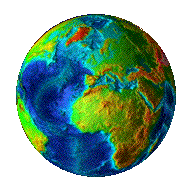
GEO 354: Climatology
Assignment #1
The Earth-Atmosphere-Sun System and Surface Temperature


|
GEO 354: Climatology
|

|
1. Does the mean global surface temperature increase or decrease with an decrease in
2. Suppose the earth was moved farther from the sun, so that in its new orbit it received only 65% of the present amount of incoming radiation. If the albedo and composition of the atmosphere remained as they are now, how much warmer or colder than present would the earth's surface be? (10 points)
3. Suppose the earth was in its current orbit with its current albedo, but it had a thin atmosphere like Mars with a greenhouse effect of .086. How much warmer or colder than present would the earth's surface be? (10 points)
4. For each of the three parameters, calculate the increase or decrease in mean global temperature for an increase of 5% of the initial value of that parameter with the other two parameters held at their initial values. List the three increases or decreases. For the increase of 5% which parameter produces the largest change in mean global temperature? (16 points)
5. If the earth's atmosphere were completely transparent to longwave radiation, what would the mean global temperature be, if incoming solar radiation and albedo remained at initial values? What does that tell you about the magnitude of the surface temperature increase due to the greenhouse effect? (10 points)
6. For Mars, incoming solar radiation = 590 W/m2, albedo = .22, and greenhouse effect = .086. What is the mean surface temperature of Mars? What are the reasons for the difference between the surface temperature of Mars and the surface temperature of Earth? (12 points)
7. For Venus, incoming solar radiation = 2614 W/m2, albedo = .75, and greenhouse effect = .990. What is the mean surface temperature of Venus? What are the reasons for the difference between the surface temperature of Venus and the surface temperature of Earth? (12 points)
8. In its current orbit and with its current albedo, what would the value of greenhouse effect need to be for Venus to have a mean temperature as close as possible to earth's mean temperature? (10 points)
9. What conclusions can you draw from questions 1 through 8? (10 points)